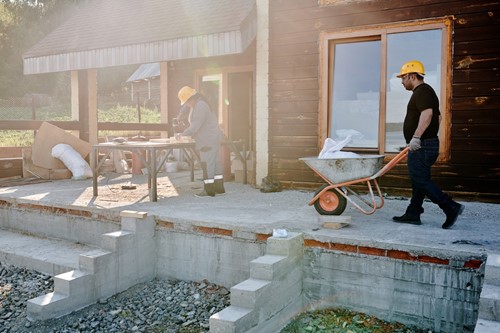
In both existing homes and new construction, there are several common types of foundations for houses. Each has their advantages and disadvantages, including specific maintenance requirements and climate-specific considerations.
Whether you’re building a new home or want to learn more about how to care for your existing home, it’s worth exploring the three major types of foundations used for houses:
Basement foundations are essentially holes dug beneath the house, matching most or all of the ground-level square footage. Builders use concrete footings around the edge of the basement space as a frame for the foundation, then follow with beams, walls and a concrete slab at the bottom.
Basement foundations can add extra living space to the home, potentially doubling the square footage if finished. Otherwise, unfinished basements serve as valuable storage space and shelter in case of extreme weather.
Concrete slab foundations are made of a simple, flat layer of concrete situated slightly below the surface of the ground. This is one of the simplest foundation types to install, involving a wire mesh and reinforcing bars within the concrete for extra stability.
Slab foundations are best for warmer regions, as frozen ground can cause cracks and shifts in the concrete. However, in the right conditions, a slab foundation will not develop weak spots or crumble over time.
Crawl space foundations have characteristics of both a basement and a slab foundation. They’re built using small concrete footings called stem walls, which create a slightly elevated space beneath the home. While you can’t use a crawl space as living space, it can be perfect for storage and access to plumbing or electrical wiring.
Crawl space foundations can help keep the home safe from flood damage, earthquake damage and termites. One disadvantage of this foundation type is the vulnerability to mold, mildew and pests who might like to make the shelter their home.
There are other types of foundations, like wood foundations and pier foundations, which are typically more specific to certain regions and types of home. There are also variations of the foundations found in this article, such as slab on grade foundations and daylight basements.
Regardless, the more you know about these three common types of concrete foundation, the more prepared you’ll be to take care of your own - whether in your current home or brand-new construction.

Welcome to my real estate website, your number one source in Real Estate. As an agent who's an expert in this local area, I bring a wealth of knowledge and expertise about buying and selling real estate here. It's not the same everywhere, so you need someone you can trust for up-to-date information. I am eager to serve you. Here are some of the things I can do for you:
Find Your Next Home
You need someone who knows this area inside and out! I can work with you to find the right home at the right price for you, including all the neighborhood amenities that matter - not to mention the essential criteria you have for your ideal home
Sell a Home
When it's time to move, you need someone who will advertise your home, show to prospective buyers, negotiate the purchase contract, arrange financing, oversee the inspections, handle all necessary paperwork and supervise the closing. I can take care of everything you need, from start to close.
Consult on Home Selling Tactics
Oftentimes buyers don't visualize living in your home the way you do. I can make your home attractive to its ideal audience - which can help you get top dollar. Things like staging the home, making repairs or minor improvements, or even simply painting the walls can be the difference between a home resting on the market and one that's sold fast.
Feel free to contact me today. I love what I do!!